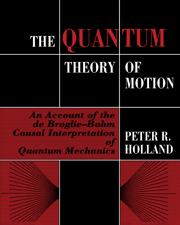 The Quantum Theory of Motion
The Quantum Theory of Motion Book contents
- Frontmatter
- Contents
- Preface
- 1 Quantum mechanics and its interpretation
- 2 Hamilton–Jacobi theory
- 3 Elements of the quantum theory of motion
- 4 Simple applications
- 5 Interference and tunnelling
- 6 The classical limit
- 7 Many-body systems
- 8 Theory of experiments
- 9 Spin ½: the Pauli theory
- 10 Spin ½: the rigid rotator
- 11 The Einstein–Podolsky–Rosen experiment and nonlocality
- 12 Relativistic quantum theory
- References
- Index
7 - Many-body systems
Published online by Cambridge University Press: 20 January 2010
- Frontmatter
- Contents
- Preface
- 1 Quantum mechanics and its interpretation
- 2 Hamilton–Jacobi theory
- 3 Elements of the quantum theory of motion
- 4 Simple applications
- 5 Interference and tunnelling
- 6 The classical limit
- 7 Many-body systems
- 8 Theory of experiments
- 9 Spin ½: the Pauli theory
- 10 Spin ½: the rigid rotator
- 11 The Einstein–Podolsky–Rosen experiment and nonlocality
- 12 Relativistic quantum theory
- References
- Index
Summary
General properties of many-body systems
Definition of individual system
So far we have studied the properties of single-body systems in prescribed external potentials. An individual physical system comprises a wave and a particle, both evolving in three-dimensional Euclidean space. Of course, isolating a system and representing the influence of other matter by an ‘external potential’ is an approximation to the real state of affairs in that we neglect the source of the potential. As a fundamental theory of matter quantum mechanics should apply to a closed many-body system (and ultimately to the universe as a whole) and reduce to a theory of systems of a few degrees of freedom as a special case under conditions where it is legitimate to neglect the ‘rest of the universe’. The extension of the quantum theory of motion to many-body systems is straightforward, although it displays some striking features not evident in the one-body case. To begin with, we define an individual n-body system as comprising:
(a) A wavefunction ψ = ψ(x1, …, xn, t) defined in a 3n-dimensional configuration space in which xl, …, xn provide a set of rectangular Cartesian coordinates.
(b) A set of n point particles pursuing trajectories xi(t) i = 1, …, n, in three-dimensional Euclidean space. A single configuration space trajectory is equivalent to n particle trajectories in Euclidean space.
When we speak of a ‘many-body system’ we mean then a single wavefunction together with a set of particles.
Information
- Type
- Chapter
- Information
- The Quantum Theory of MotionAn Account of the de Broglie-Bohm Causal Interpretation of Quantum Mechanics, pp. 277 - 323Publisher: Cambridge University PressPrint publication year: 1993
Accessibility standard: Unknown
Why this information is here
This section outlines the accessibility features of this content - including support for screen readers, full keyboard navigation and high-contrast display options. This may not be relevant for you.Accessibility Information
- 1
- Cited by